December 2024
The global consumer robotics market size is calculated at USD 13.69 billion in 2025 and is forecasted to reach around USD 102.31 billion by 2034, accelerating at a CAGR of 25.04% from 2025 to 2034. The North America market size surpassed USD 3.94 billion in 2024 and is expanding at a CAGR of 25.22% during the forecast period. The market sizing and forecasts are revenue-based (USD Million/Billion), with 2024 as the base year.
The global consumer robotics market size accounted for USD 10.95 billion in 2024 and is predicted to increase from USD 13.69 billion in 2025 to approximately USD 102.31 billion by 2034, expanding at a CAGR of 25.04% from 2025 to 2034. Factors such as increasing consumer demand for convenience, growing popularity of automation solutions, rising concerns over cleanliness, and rapid technological innovations are expected to drive the growth of the consumer robotics market throughout the forecast period.
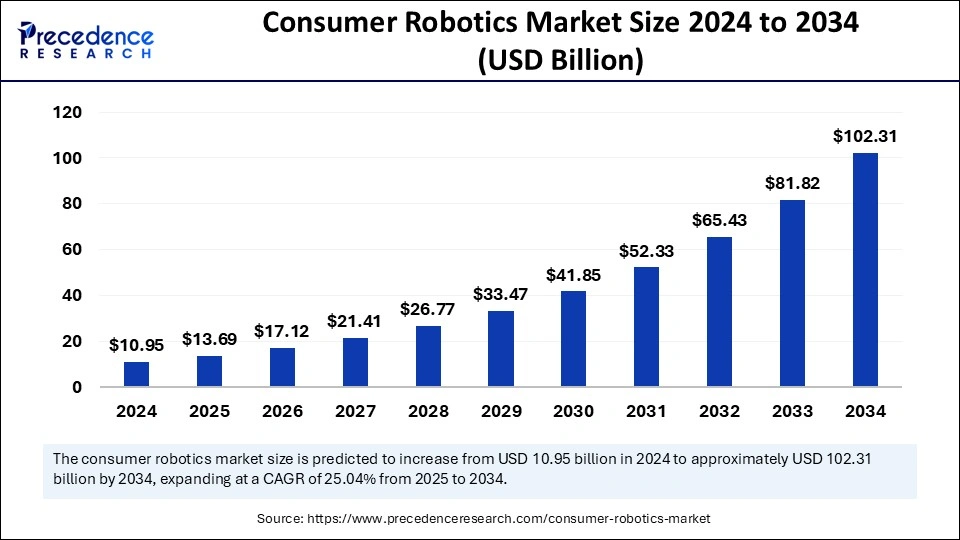
The integration of artificial intelligence (AI) emerges as a game-changer and holds great potential to impact the growth of the market positively. AI-powered consumer robotics can perform various tasks efficiently, accurately, and independently. It can process massive data and make decisions based on that data, AI integration is widely used to enhance the capabilities of consumer robotics in numerous ways. AI can enhance the consumer robots' communication and social skills. AI in consumer robotics can also significantly improve the ability of consumer robots to interact with their environment and perform several tasks. For instance, an AI-powered robot vacuum cleaner is able to learn the layout of a home over time, which allows it to clean the floor more effectively and, as a result, become more personalized over time.
The U.S. consumer robotics market size was exhibited at USD 2.76 billion in 2024 and is projected to be worth around USD 26.33 billion by 2034, growing at a CAGR of 25.30% from 2025 to 2034.
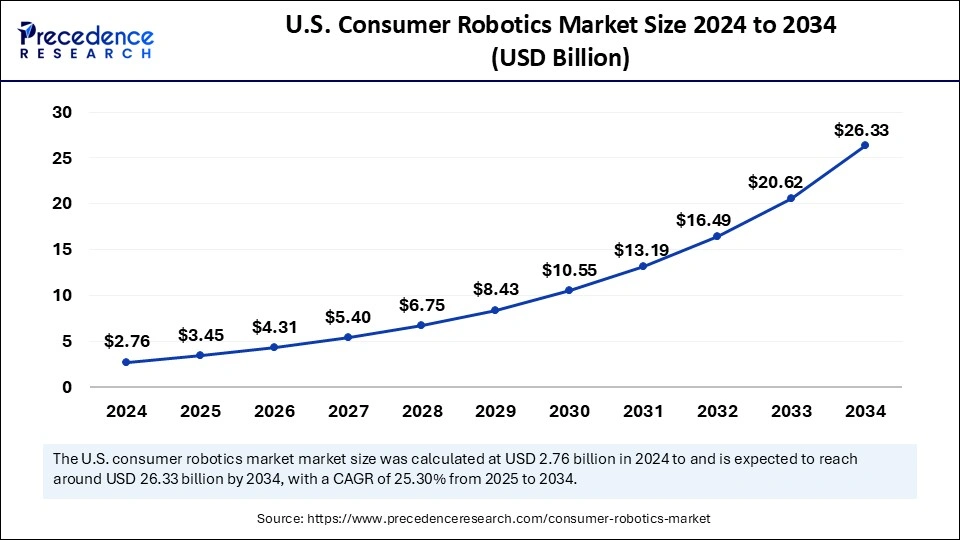
North America held the dominant share of the consumer robotics market in 2024. The regional market growth is driven by increased R&D investments, the rising presence of tech-savvy consumers, and the rapid adoption of Artificial Intelligence (AI). With the increased trend of smart homes, the adoption of consumer robots has increased in the region due to their ability to interact with other devices in the home to automate tasks, which results in making life easier for homeowners. The market in the region is expected to expand at a steady growth rate owing to the growing demand for assistive robots in elderly care, healthcare, and rehabilitation. Other factors, such as rising demand for cleanliness automated solutions, the rapid pace of urbanization, the surge in disposable income, and the rising need for assistance in daily activities, further support the market’s growth.
Asia Pacific is expected to witness the fastest growth due to the increasing demand for automation solutions, rising disposable incomes, high R&D investments, rapid urbanization, and a growing tech-savvy population. In addition, the surge in the aging population is expected to drive the market’s growth during the forecast period. With a rising elderly population and the increasing focus on remote patient monitoring, these robots can act as companions, providing medication reminders and mobility assistance. The rising manufacturing capabilities and advancements in 5G connectivity, AI, and IoT are expected to accelerate the market’s growth. In addition, the increasing awareness regarding the benefits of automation solutions for household chores, along with the growing demand for efficiency and convenience, is likely to boost the demand for consumer robotics in multiple applications.
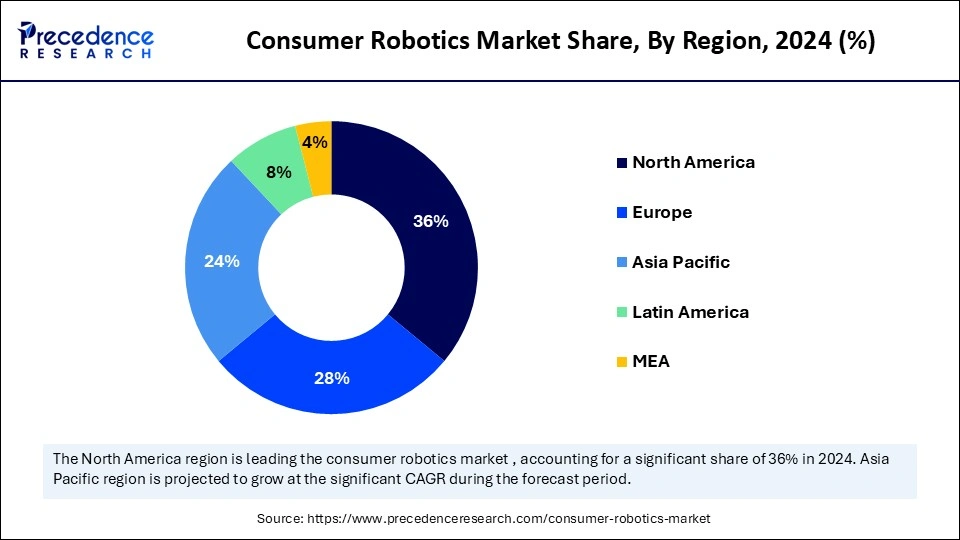
The European consumer robotics market is expected to expand at a notable rate during the forecast period. The region boasts a well-established tech-driven environment, which significantly increased the acceptance of AI-powered smart home devices and automation technologies. There is a high demand for automation solutions in households. The rising disposable incomes and rapid technological advancements further support regional market growth. Moreover, the increasing investment in consumer robots that offer automation for security, cleaning, and entertainment and the increasing adoption of personal assistant robots, robotic vacuum cleaners, and home security robots contribute to regional market growth.
In today’s era, robotics is playing a crucial role in modern life. The consumer robotics market involves developing, producing, and utilizing robotic devices that are specifically designed for personal or domestic use rather than industrial use. Consumer robotics are robots that are usually portable, small in size, and easy to operate. Some of the most widely adopted consumer robotics include home cleaning robots, personal assistance robots, entertainment robots, robotic lawn mowers, educational robots, robotic pets, healthcare and monitoring robots, and telepresence robots.
| Report Coverage | Details |
| Market Size by 2034 | USD 102.31 Billion |
| Market Size in 2025 | USD 13.69 Billion |
| Market Size in 2024 | USD 10.95 Billion |
| Market Growth Rate from 2025 to 2034 | CAGR of 25.04% |
| Dominating Region | North America |
| Fastest Growing Region | Asia Pacific |
| Base Year | 2024 |
| Forecast Period | 2025 to 2034 |
| Segments Covered | Mode, Connectivity, Product and Regions |
| Regions Covered | North America, Europe, Asia-Pacific, Latin America, and Middle East & Africa |
Rising Adoption of Robotics in Households
The growing adoption of robotics in households is driving the growth of the consumer robotics market. Consumer robotics is continuously evolving through ongoing technological advancement, creating more user-friendly, portable, affordable, easy-to-use, and versatile robotic devices for various household tasks. Consumer robotics is developed to provide specific services to individuals in their homes or personal spaces. From lawnmowers and vacuum cleaners to personal assistants, robots are increasingly becoming more integrated into the daily lives of humans. Consumer robotics is widely performing numerous tasks that were once considered the exclusive domain of humans in households.
Complexity of Integration and Compatibility
The increasing complexity of integration and compatibility is anticipated to hamper the market's growth. In addition, job displacement is one of the potential risks associated with consumer robotics. For instance, according to the McKinsey Global Institute study, by 2030, between 400 million and 800 million employees around the world could be displaced by automation. Such factors are likely to limit the expansion of the global consumer robotics market.
Rising Popularity of Automation Solutions
The increasing popularity of automation solutions is projected to offer lucrative opportunities to the consumer robotics market. Consumer robotics is one of the major applications of robotic technology and is gaining immense popularity in automating everyday tasks with higher efficiency than humans. It includes a wide range of products, such as pool cleaning robots, robot vacuums, lawn mowing robots, and other home automation systems. Over the past few years, the market has observed that the demand for consumer robots has been rapidly increasing due to their rising accessibility and affordability for consumers. Moreover, as robotics technology continues to evolve, several market players, such as Neato Robotics, Bossa Nova Robotics, and others, are continuously focusing on developing innovative automation products to keep up with trends to remain competitive as well as provide the utmost value to their customers through improved quality at affordable costs.
The semi-autonomous segment dominated the consumer robotics market with the largest share in 2024. The segment growth is driven by the rising consumer demand for convenient solutions. As consumers increasingly seek a balance between manual control and automation, the demand for semi-autonomous robots increases. Semi-autonomous robots are widely used for various domestic applications due to their ease of use, efficiency, and cost-effectiveness. Semi-autonomous robots are designed to execute given tasks based on commands given to them. These robots play a crucial role in performing household chores. Some of the popular products include semi-autonomous robotic lawnmowers, vacuum cleaners, and others that operate independently, and are also being guided via voice commands or apps.
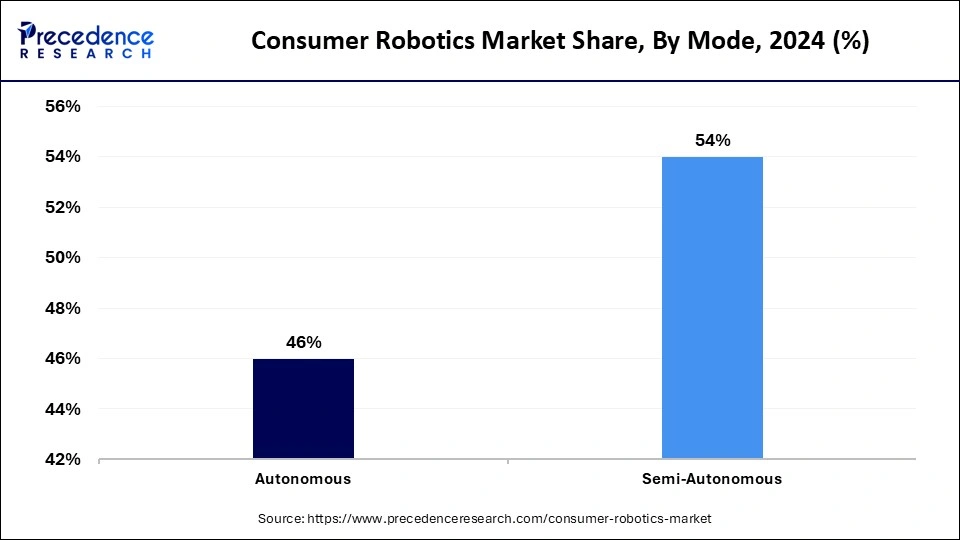
On the other hand, the autonomous segment is expected to witness the fastest growth during the forecast period. The growth of the segment can be attributed to the increasing adoption of smart home ecosystems, particularly in developed and developing countries. Autonomous robots are designed to integrate with IoT-enabled devices. The consumers' preference for consumer robotics can perform various household tasks independently tasks, such as home cleaning, lawn mowing, health monitoring, and home security monitoring, without the intervention of humans. Therefore, increasing consumer demand for convenience and efficiency is likely to propel the growth of the segment.
The Wi-Fi segment held the largest share of the consumer robotics market in 2024, owing to the rising adoption of smart home ecosystems. Wi-Fi uninterruptedly connects the majority of consumer robots. Wi-Fi connectivity enables consumer robots to smoothly integrate with Internet of Things (IoT) devices, voice assistants, and various home automation systems. Robots for health monitoring, lawn mowing, home cleaning, entertaining, personal assistance, and security use Wi-Fi to integrate into smart home systems. Wi-Fi-enabled consumer robots can be remotely controlled and scheduled via smartphone apps and also play an integral role in enhancing convenience, efficiency, and automation.
Meanwhile, the Bluetooth segment is expected to grow significantly during the projection period. This is mainly due to the increasing consumers' preference for rapid and hassle-free connectivity between smart devices and their robots. Bluetooth enables pairing with electronic devices such as tablets, smartphones, and smart home hubs, which allows users to control robots without depending on cloud services or Wi-Fi. Bluetooth connectivity is gaining immense popularity in robotic toys, robotic pets, wearable robots, and personal assistance robots.
The household robots segment led the consumer robotics market in 2024. This is mainly due to the increasing acceptance of consumer robotics in smart homes. Household robotics allows consumers to perform everyday tasks efficiently, including vacuuming carpets and cleaning floors without human intervention. These robots that integrate with AI and deep learning technology have been developed for higher accuracy and efficiency while performing daily routine tasks like mopping or sweeping floors. Therefore, the adoption of household robots provides homeowners with automated solutions that assist in saving time with low effort and allow more free time for other activities or simply relaxing.
On the other hand, the social robots segment is expected to grow at the fastest rate during the forecast period. Social robots are increasingly gaining popularity due to the rapid advancements in Artificial Intelligence (AI), facial recognition, and natural language processing (NLP), enabling to development of more interactive and intelligent robots. Social robots are extensively integrated into healthcare facilities, smart homes, and educational institutions. These robots can easily recognize human emotions, actively engage in conversations, and respond based on human expressions or emotions, which increases their adoption for children’s education and entertainment, elderly care, and healthcare.
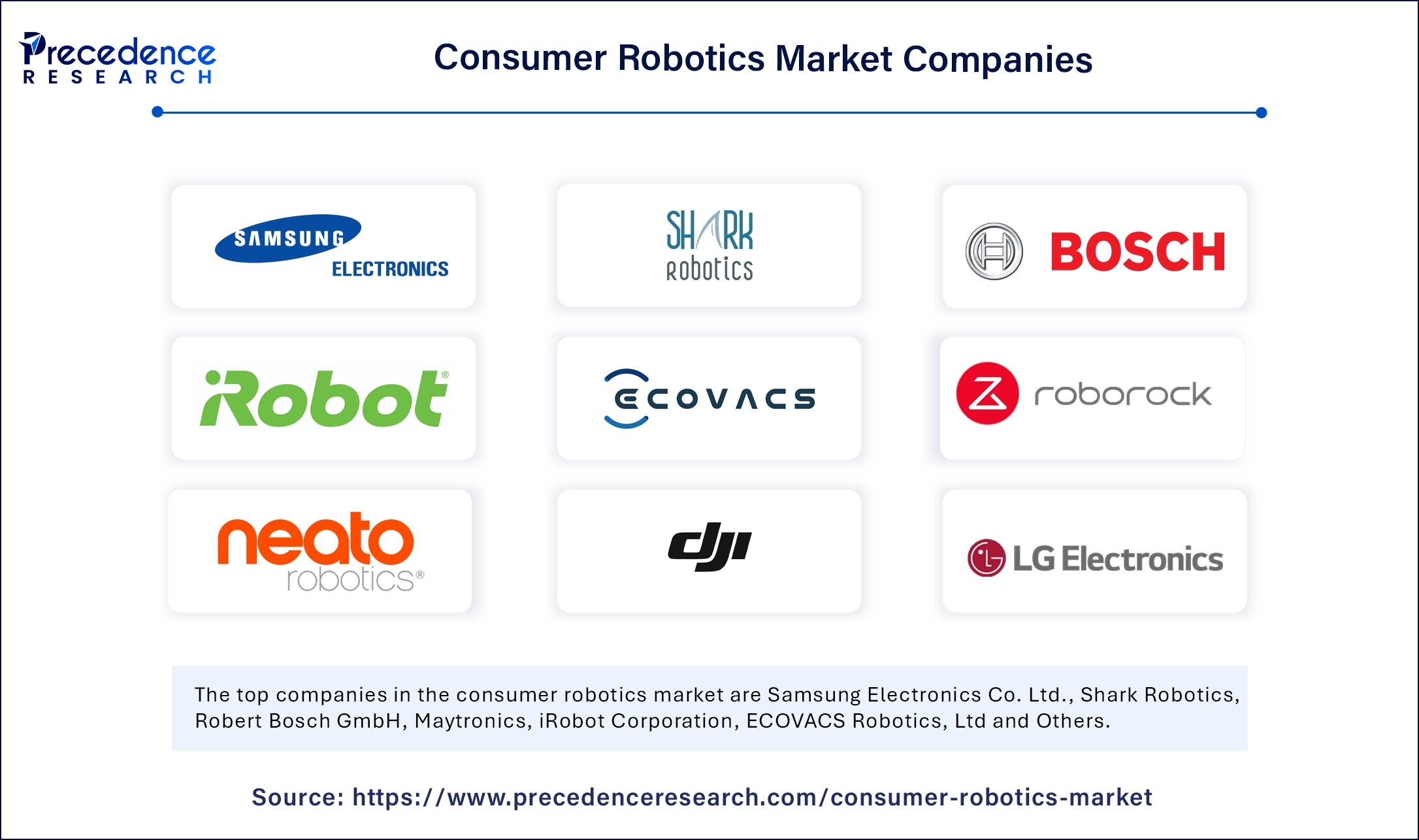
By Mode
By Connectivity
By Product
By Region
For inquiries regarding discounts, bulk purchases, or customization requests, please contact us at sales@precedenceresearch.com
No cookie-cutter, only authentic analysis – take the 1st step to become a Precedence Research client
December 2024
October 2023
July 2024
July 2024